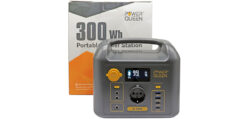
Practical testing …
Power Queen P300W test in practice
Power Queen P300W Charging …
Volume when charging the Powerstation …
Power Queen P300W discharged …
Power Queen P300W output …
Powerstation temperature …
Power Queen P300W efficiency …
Powerstation grounding …
Power Queen P300W test in practice …
After all the information about the Powerstation, let’s now move on to the actual practical testing of the Power Queen P300W Powerstation. We have now been using the Powerstation continuously for a few weeks and have been able to gather some experience that will certainly be helpful for some people.
Power Queen P300W Charging …
At this point, we’ll start again with a simple setup, where we charged the Powerstation with the supplied plug-in power supply unit. Although we don’t have a solar panel from Power Queen in the test, we still wanted to try out how well charging via PV works. So we quickly connected a 100W solar panel from another manufacturer via the MC4 cable for a few days to check the charging function.
As mentioned on the previous page, the Powerstation is charged via the DC5521 socket on the front of the device – whether from a solar panel, a car or via the 230V mains adapter. The power measurement shows a relatively even power consumption of approx. 52.8 watts.
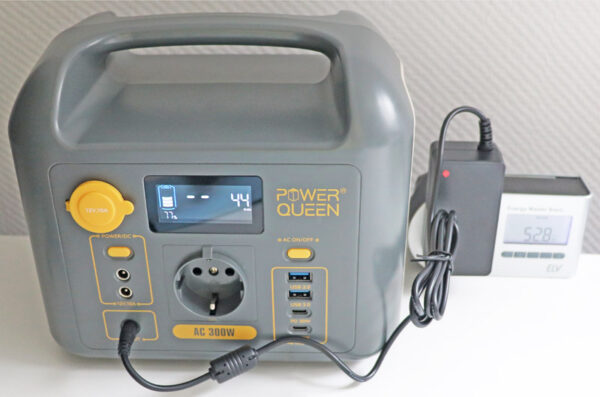
As soon as the charging process is complete, the power requirement drops to approx. 1.3 watts.
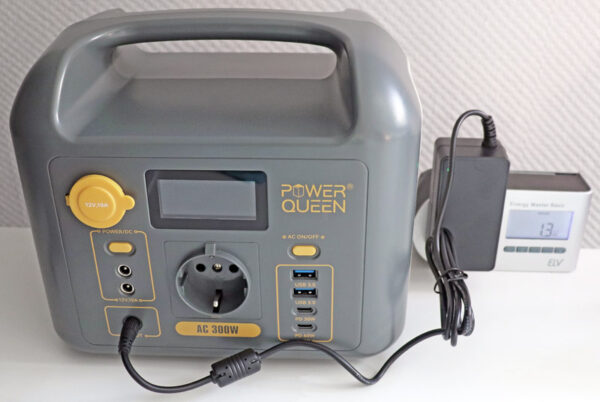
Without the power station, consumption drops to 0.1 watts.
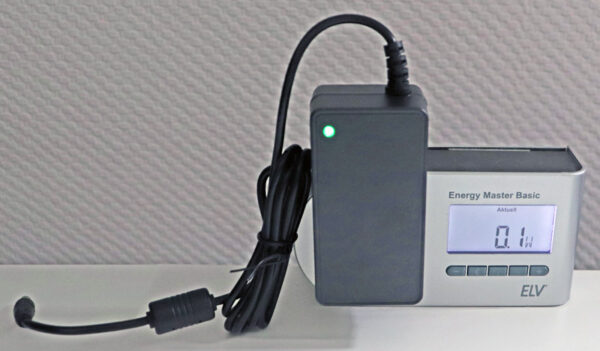
These are all excellent values! However, the charging time of just over 7 hours is not so excellent, as this is of course quite a long charging time. The total power requirement is approximately 340 Wh. That’s about 13 percent more than the total capacity of the Powerstation. However, it should be noted that the battery still had or retains approx. 5 percent capacity when empty.
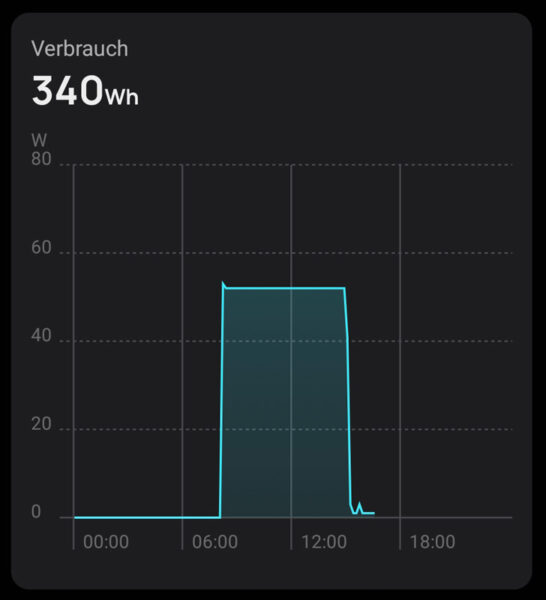
Volume when charging the power station …
It is very positive to note that no fan was required when charging the Power Queen P300W and the entire charging process was therefore noiseless.
Power Queen P300W Discharge …
Now we have loaded the power station with different current draws and check what exactly happens. We start with a load of approx. 50 watts, then increase to 150 watts, 200 watts, 250 watts, 300 watts, 350 watts, 400 watts and finally load the power station with 450 watts, where it then outputs the error code E03, which signals nothing other than an overload at the AC output. The maximum total output power of the Power Queen P300W Powerstation is therefore approx. 400 watts.
We have edited the entire process into a short on YouTube on our Funkyhome YouTube channel, where you can see the different load levels and listen to the fan noise. If you activate the subtitles in YouTube, you can also see the respective performance. At the end, don’t be alarmed if the headset or speakers are set a little louder 😉
Note: Please allow our cookies first to see this external content!
Power Queen P300W output …
The maximum AC output power of the Power Queen P300W Powerstation is 300 watts. The Powerstation delivers this power without any problems. We were even able to elicit up to approx. 400 watts from the Powerstation as shown above. Before you can use the AC output, you must first switch on the power station by pressing and holding the left button and then switch on the AC output by briefly pressing the right button. The AC output is deactivated after a certain time (after approx. 8 hours without load). The Powerstation switches itself off after approx. 8 hours if no device is connected and the Powerstation is not being charged.
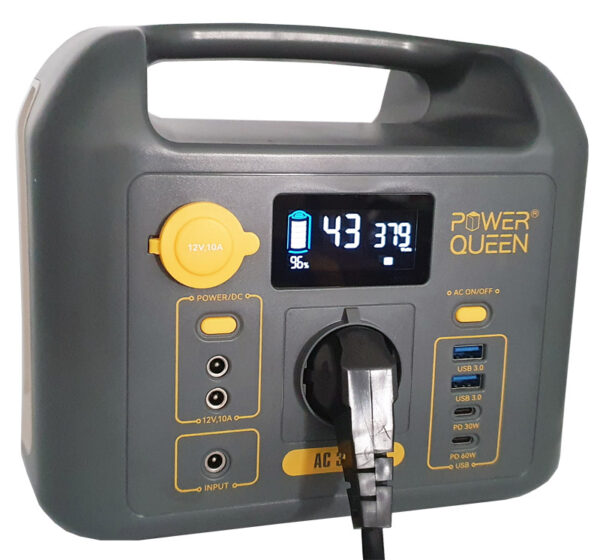
Incidentally, there is no such thing as an X-Boost. This means that you cannot simply connect an appliance with more than 300-400 watts of power, as the power station would switch off immediately. Washing machines, radiators and hair dryers can therefore generally not be used on the AC output of this power station.
As we couldn’t find any information in the manual as to whether the Power Queen P300W really delivers 230V and 50Hz pure sine wave, we checked the AC output a little more closely. Because if you want to use the power station to operate devices with an electronic power supply, a pure sine wave signal should really be available at the AC output. And if you are using devices with a simple clock that use a mains frequency as a time base, this mains frequency should be as close as possible to 50 Hertz (Europe) or 60 Hertz (USA). Incidentally, the mains frequency can be switched from 50 Hz to 60 Hz by pressing Power and AC at the same time. The output voltage, on the other hand, is not quite as important and may be 230 volts with a deviation of +- 10 percent. A voltage range of 207 volts to 253 volts would therefore be permissible.
Let’s start by measuring the current signal with an oscilloscope to determine whether it is a clean sine wave, i.e. a pure sine wave, or a square, modified sine wave, which should be as smooth as possible for devices with electronic power supplies. Fortunately, as we can see at first glance, a sine wave signal is output via the Power Queen P300W 230V AC output.
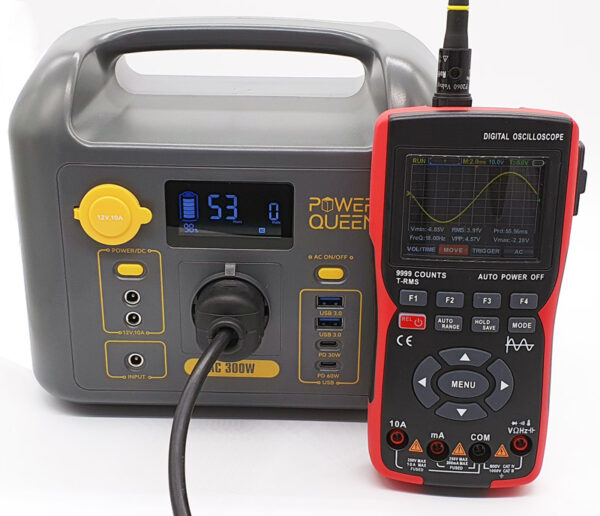
Only on closer inspection can you see a very tiny corner in the AC voltage, but this is not really noticeable during operation. The frequency, which according to the oscilloscope is exactly 50.00 Hz, is very well done.
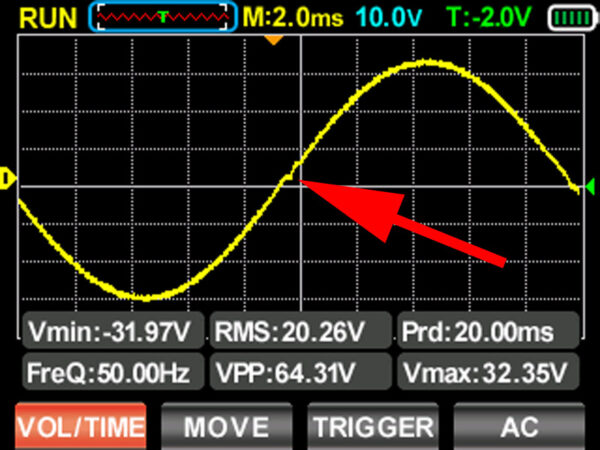
To get a small comparison to another power station, we have created a measurement of the EcoFlow River 2 Pro Powerstation here, where the signal really does correspond to a perfect sine wave.
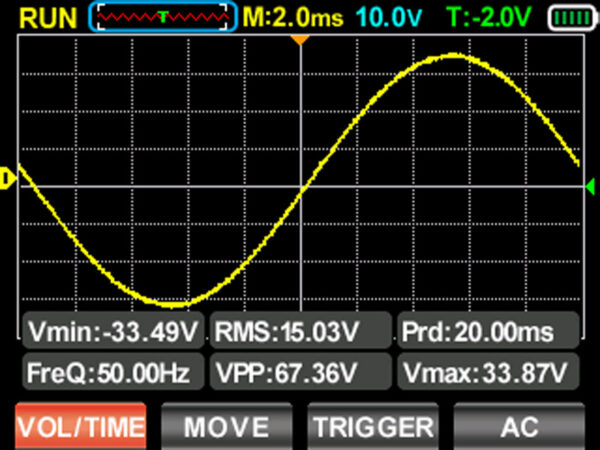
But now let’s get back to the Power Queen P300W, because we also took this opportunity to check the output voltage and see that it is almost 220 volts, which remains the same with and without load. The voltage is therefore completely within the prescribed voltage range of 207 volts to 253 volts.
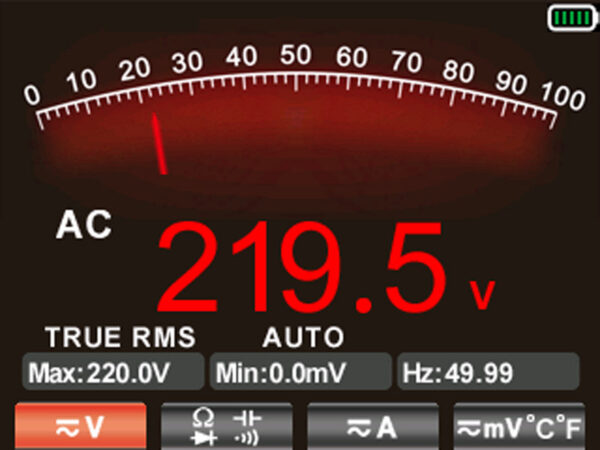
Powerstation temperature …
The battery itself does not need to be actively cooled by the fan. However, it is important that the temperature of the components in the inverter and rectifier segment remain cool at all times and this is achieved well and relatively quietly with the two integrated 40 mm fans. Overall, however, it is noticeable that the fans used are only switched on and off in very coarse steps. Instead of the 2-pole DC fans, Power Queen could use a PWM fan and regulate it to the actual demand using stepless PWM control. This would significantly reduce the volume even further. Incidentally, a battery must not become too cool, as this would reduce performance and efficiency enormously. This is particularly important for outdoor use. The charging temperature is recommended to be between 0 and +40°C. The discharge temperature should be between -5 and +45°C.
Power Queen P300W efficiency …
During discharge, we were able to elicit a maximum runtime of 53 minutes from the 300 Wh (watt hours) battery at full load of approx. 300 watts, until the power station reached its minimum charge level of 5 percent and automatically initiated the shutdown of the power station with the error code E12. Equal to approx. 265 Wh and thus a discharge efficiency of approx. 89 percent. Strictly speaking, however, we initially needed an energy requirement of 340 Wh to fully charge the 300 Wh battery, which means we can calculate a charging efficiency of approx. 88%. Including charging and discharging at 300 watts of power, we still get an efficiency of approx. 78 percent (plus the remaining discharge limit of approx. 5 percent battery capacity, although this reserve cannot be used). Every voltage conversion is accompanied by a loss. This is also noticeable if the power station is only operated with a low load. Unfortunately, this also reduces the efficiency. If you only charge your smartphone with a few watts, the efficiency could even be well below 70%, but this is probably rarely the case.
Powerstation grounding …
Speaking of stand-alone solutions, the connected devices are logically only earthed if a power station is also connected to an earth connection. This would therefore not be the case with pure solar panel operation. As Power Queen uses a power supply unit with a two-pole Euro plug without earthing contact for the P300W Powerstation, there is no earthing even in mains operation.
The application possibilities of the 300 Wh Powerstation know only performance limits, but hardly any limits in terms of the variety of connection options. The values measured in our extensive practical testing are certainly in the green zone and are quite respectable. We would now like to slowly but surely come to the end and present our conclusion on the Power Queen P300W Powerstation on the next page.
Now we come to the Power Queen P300W Powerstation Result and general impression …
